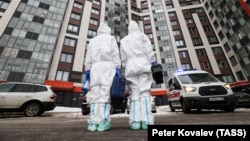Russia's population declined by more than half a million in 2021, and COVID-19 is being blamed as one of the main reasons.
Russia had a population of 145.5 million in January, nearly 700,000 fewer people than a year earlier, according to figures published by the Rosstat state statistics service on January 28.
Deputy Prime Minister Tatyana Golikova said COVID-19 was the main reason for the downward trend.
Officially, Russia’s COVID-19 task force has recorded 329,000 deaths due to COVID-19 since the start of the pandemic, but the number of deaths reported by Rosstat is more than twice that.
Russian officials have attributed the difference to the fact that the task force only includes deaths for which COVID-19 was the main cause and uses data from medical facilities.
Rosstat uses broader criteria for counting deaths linked to the virus and takes its numbers from civil registry offices where the registration of a death is finalized.
Russia has announced a series of records in recent days as a wave of cases of the omicron strain spreads through the country.
On January 29, Russia's daily coronavirus cases exceeded 100,000 for the first time since the pandemic began.
The country’s coronavirus task force confirmed 113,122 new daily infections, setting a record high for a ninth consecutive day. It said that 668 deaths had been confirmed in the past 24 hours.
Meanwhile, Hungary's daily tally of new COVID-19 cases could reach 30,000 by mid-February, up from about 20,000 this week, a government minister said on January 29.
Miklos Kasler, the country's minister for human resources, blamed the omicron variant for the expected rise. In a video posted on Facebook, he said the variant was causing less severe illness, but that the one-third of Hungarians who were not vaccinated were at higher risk.
Just over 6 million of Hungary's 10 million people have received at least two shots, and nearly 3.6 million have also received a booster, but the country's vaccination rate lags behind Western European levels.
